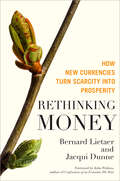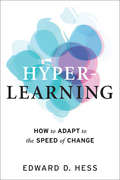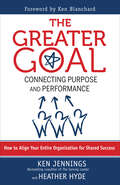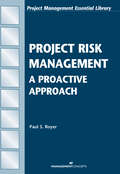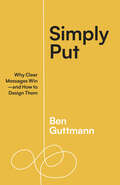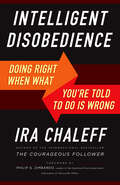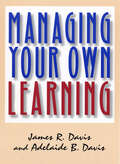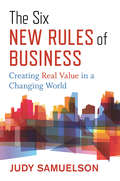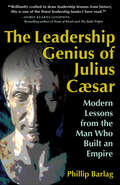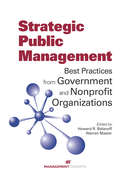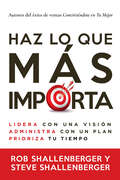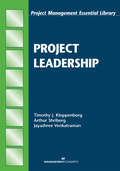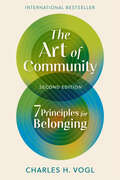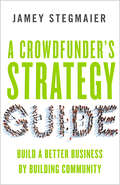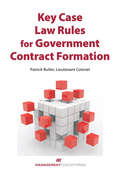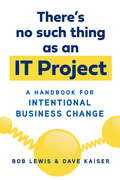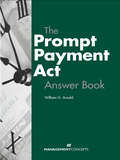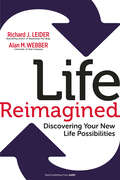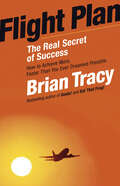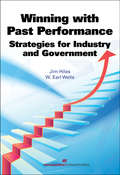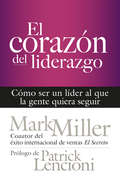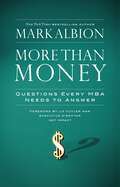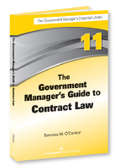- Table View
- List View
Rethinking Money: How New Currencies Turn Scarcity into Prosperity
by Jacqui Dunne Bernard LietaerAs the United States struggles and the economies of Europe stagger, we fail to see a way out of this agonizing cycle of repeated financial meltdowns. In fact, there are thousands of ways to solve not only our recurring fiscal crises but our ongoing social and ecological debacles as well. Solutions are already in place where terrible problems once existed. The changes came about not through increased conventional taxation, enlightened self-interest, or government programs but by people simply rethinking the concept of money. With this restructuring, everything changes. In this visionary book, Bernard Lietaer and Jacqui Dunne explore the origins of our current monetary system—built on bank debt and scarcity—revealing the surprising and sometimes shocking ways its unconscious limitations give rise to so many serious problems. But there is hope. The authors present stories of ordinary people and their communities using new money, working in cooperation with national currencies, to strengthen local economies, create work, beautify cities, and provide education—and so much more is possible. These real-world examples are just the tip of the iceberg—over 4,000 cooperative currencies are already in existence. The book provides remedies for challenges faced by governments, businesses, nonprofits, local communities, and even banks. It demystifies a complex and critically important topic and will strike a deep chord with readers eager to find innovative, meaningful solutions that will do far more than restore prosperity—it will provide the framework for an era of sustainable abundance.
Hyper-Learning: How to Adapt to the Speed of Change
by Edward D. Hess"Ed Hess's Hyper-Learning is uniquely practical and is the essential starting point for charting new ways of thinking, living, working, leading, and being fulfilled in our new world." —Gary Roughead, Admiral, US Navy (retired) former Chief of Naval Operations The Digital Age will raise the question of how we humans will stay relevant in the workplace. To stay relevant, we have to be able to excel cognitively, behaviorally, and emotionally in ways that technology can't.Professor Ed Hess believes that requires us to become Hyper-Learners: continuously learning, unlearning, and relearning at the speed of change. To do that, we have to overcome our reflexive ways of being: seeking confirmation of what we believe, emotionally defending our beliefs and our ego, and seeking cohesiveness of our mental models. Hyper-Learning requires a new way of being and a radical new way of working. In Part 1 of this how-to book, Hess takes a practical workbook approach and helps readers create their Hyper-Learning Mindset, choose and embrace their needed Hyper-Learning Behaviors, and adopt their daily Hyper-Learning Practices. In Part 2, Hess focuses on how to humanize the workplace to optimize Hyper-Learning. Featuring case studies of three business leaders and two public companies, this book shows how to harness the power of human emotions, choices, and behaviors to enable the highest levels of human cognitive, emotional, and behavioral performance—individually and organizationally.
The Greater Goal: Connecting Purpose and Performance
by Ken Jennings Heather HydeOne of the most powerful forces on Earth is an organization fully aligned, individual by individual, team by team, to achieve mutual success. In this vivid business story, Ken Jennings and Heather Hyde provide a road map to guide leaders through the process of engaging employees at all levels of the organization to find the deeper meaning and higher purposes of their work. Learning these methods is Alex Beckley, a leader who receives a wake-up call that inspires him to live and lead differently. He discovers how to invite his coworkers to join a cause, not just a company—to commit to a Greater Goal—and lead the process of shared goal achievement. Alex learns the Star Model, a process encompassing five practices that can help you discover and deliver on your own purpose and passions, in alignment with many others, to accomplish something good and great. Come along on the adventure!
Project Risk Management: A Proactive Approach
by Paul S. Royer PMPYou don't need sophisticated statistical analysis or software to improve the probability of project success. This book offers a proactive project management process for managing project risk from project initiation through planning, execution, control and closure. In addition, you'll apply a new technique for program risk auditing that lets you explore risk in multiple related projects. You'll learn how to uncover hidden risk during the planning phase and how to track and manage it throughout the project. You'll also learn to enhance project value by building a risk management repository to support ongoing knowledge transfer.
Simply Put: Why Clear Messages Win—and How to Design Them
by Ben GuttmannStop complicating everything! Create simple messages that are more powerful, more memorable, and win people over.Simply Put is a modern exploration of the simplicity principle for anybody who needs to sell stuff or persuade others. This book is a splash of cold water, designed to wake up entrepreneurs, C-suite executives, and marketing pros who have something they need to tell the world but just can't quite connect the dots. With this book, we're all better marketers.So why does simple win? And how do we get simple? The award-winning marketing entrepreneur behind New York Times best-selling authors and notable campaigns such as I Love NY provides answers and tools to simplify messages in this practical guide. From Yes We Can to Just Do It, regardless of if they're trying to get your dollars, your votes, or just your thoughts, effective messages share one thing they're simple. Being able to tell your story clearly and effectively is the winning skill for the next generation of entrepreneurs and leaders.
Intelligent Disobedience: Doing Right When What You're Told to Do Is Wrong
by Ira ChaleffWhen It's Smart to Say NoNearly every week we read about a tragedy or scandal that could have been prevented if individuals had said no to ill-advised or illegitimate orders. In this timely book, Ira Chaleff explores when and how to disobey inappropriate orders, reduce unacceptable risk, and find better ways to achieve legitimate goals.The inspiration for the book, and its title, comes from the concept of intelligent disobedience used in guide dog training. Guide dogs must recognize and resist a command that would put their human and themselves at risk and identify safer options for achieving the goal. This is precisely what Chaleff helps humans do. Using both deeply disturbing and uplifting examples, as well as critical but largely forgotten research, he shows how to create a culture where, rather than "just following orders," people hold themselves accountable to do the right thing, always.
Managing Your Own Learning
by James R. Davis Adelaide B. DavisDescribes seven major ways of learning and shows how each can best be used to maximize self-directed learning Provides a step-by-step guide to assessing previous learning and designing an action plan for future learning Reveals how to expand opportunities for learning and use libraries and the Internet more effectively As the pace of change in the workplace continues to accelerate, individuals are under more pressure to learn new things than ever before. While most people realize they have more to learn, many have trouble translating that anxious need into purposeful action. Managing Your Own Learning demonstrates how to analyze previous learning, design an action plan for future learning, expand opportunities for learning, and use libraries and the Internet effectively to become a lifelong learner. James and Adelaide Davis detail seven major ways of learning: learning new skills, learning from presentations, learning to think, learning to solve problems and make decisions, learning in groups, learning through virtual realities, and learning from experience. They also provide useful guidelines for maximizing results by becoming an effective, active participant in learning. They explain, for example, how learning in a group can be enhanced by knowing how a group works and considering factors such as group size, cohesion, task and process behavior, and participant roles, as well as the things that can go wrong in groups, such as conflict and apathy. For each of the seven ways of learning, the authors tell what is unique about it, how learning actually takes place, and how it can be augmented in each situation. They reveal how the theory behind each way of learning originated, what researchers have learned about it, and what the individual's role is as a participant. And at the end of each chapter, they include a list of ten things that anyone can do to get the most from that particular type of learning. No matter what our previous experiences with learning may have been, we all must become self-directed learners if we are to succeed in this new era. Managing Your Own Learning provides step-by-step, proven advice on how to succeed in the 21st century workplace by becoming a proactive, goal-directed, perpetual learner.
The Six New Rules of Business: Creating Real Value in a Changing World
by Judy SamuelsonThe rules of business are changing dramatically. The Aspen Institute's Judy Samuelson describes the profound shifts in attitudes and mindsets that are redefining our notions of what constitutes business success.Dynamic forces are conspiring to clarify the new rules of real value creation—and to put the old rules to rest. Internet-powered transparency, more powerful worker voice, the decline in importance of capital, and the complexity of global supply chains in the face of planetary limits all define the new landscape. As executive director of the Aspen Institute Business and Society Program, Judy Samuelson has a unique vantage point from which to engage business decision makers and identify the forces that are moving the needle in both boardrooms and business classrooms. Samuelson lays out how hard-to-measure intangibles like reputation, trust, and loyalty are imposing new ways to assess risk and opportunity in investment and asset management. She argues that "maximizing shareholder value" has never been the sole objective of effective businesses while observing that shareholder theory and the practices that keep it in place continue to lose power in both business and the public square. In our globalized era, she demonstrates how expectations of corporations are set far beyond the company gates—and why employees are both the best allies of the business and the new accountability mechanism, more so than consumers or investors. Samuelson's new rules offer a powerful guide to how businesses are changing today—and what is needed to succeed in tomorrow's economic and social landscape.
The Leadership Genius of Julius Caesar: Modern Lessons from the Man Who Built an Empire
by Phillip BarlagThe Leadership Genius of Julius CaesarModern Lessons from the Man Who Built an Empire"Brilliantly crafted to draw leadership lessons from history, this is one of the finest leadership books I have read."—Doris Kearns Goodwin, bestselling author of Team of Rivals and The Bully PulpitLeaders are always trying to get better, which is why there is an enormous and growing collection of literature offering the latest leadership paradigm or process. But sometimes the best way to move forward is to look back. Philip Barlag shows us that Julius Caesar is one of the most compelling leaders of the past to study—a man whose approach was surprisingly modern and extraordinarily effective. History is littered with leaders hopelessly out of touch with their people and ruthlessly pursuing their own ambitions or hedonistic whims. But Caesar, who rose from impoverished beginnings, proved by his words and deeds that he never saw himself as being above the average Roman citizen. And he had an amazing ability to generate loyalty, to turn enemies into allies and allies into devoted followers. Barlag uses dramatic and colorful incidents from Caesar's career—being held hostage by pirates, charging headlong alone into enemy lines, pardoning people he knew wanted him dead—to illustrate what Caesar can teach leaders today. Central to Barlag's argument is the distinction between force and power. Caesar avoided using brute force on his followers, understanding that fear never generates genuine loyalty. He exercised a power deeply rooted in his demonstrated personal integrity and his intuitive understanding of people's deepest needs and motivations. His supporters followed him because they wanted to, not because they were compelled to. Over 2,000 years after Caesar's death, this is still the kind of loyalty every leader wants to inspire. Barlag shows how anyone can learn to lead like Caesar.
Strategic Public Management: Best Practices from Government and Nonprofit Organizations
by Howard R. Balanoff; Warren MasterReal-life Solutions to the Challenges Facing Public Administrators!Complex management issues in the public sector can't be addressed with limited, short-term fixes. Strategic, well-conceived approaches are critical to meet your organization's long-term needs. Through expert advice and real-world examples, Strategic Public Management: Best Practices from Government and Nonprofit Organizations presents the solutions that today's public administrators are putting into practice to address a variety of challenges, including planning and managing core mission functions, integrating new technology, and pursuing measurable results.Nineteen contributors representing local and federal government, nonprofit organizations, and the academic world offer guidance, direction, and examples that focus on the many areas of concern to public sector professionals, including:• Program operations• Human capital issues• Risk management• Acquisition hurdles• IT solutions• Performance parametersThis critical resource is easy to read and navigate, and the expert viewpoints provide essential best practices for mid- and senior-level professionals. Tackle your organization's complex issues today by applying proven strategies!
Haz lo que más importa: Lidera con una visión, administra con un plan, prioriza tu tiempo
by Rob Shallenberger Steve ShallenbergerTime management remains a huge challenge for most people. This book shares the habits and processes used by top leaders worldwide to minimize distractions and maximize accomplishments.In researching more than 1,260 managers and executives from more than 108 different organizations, Steve and Rob Shallenberger discovered that 68 percent of them feel like their number one challenge is time management, yet 80 percent don't have a clear process for how to prioritize their time.Drawing on their forty years of leadership research, this book offers three powerful habits that the top 10 percent of leaders use to Do What Matters Most. These three high performance habits are developing a written personal vision, identifying and setting Roles and Goals, and consistently doing Pre-week Planning. And Steve and Rob make an audacious promise: these three habits can increase anyone's productivity by at least 30 to 50 percent. For organizations, this means higher profits, happier employees, and increased innovation. For individuals, it means you'll find hours in your week that you didn't know were there--imagine what you could do!You will learn how acquiring this skillset turned an "average" employee into her company's top producer, enabled a senior vice president to reignite his team and achieve record results, transformed a stressed-out manager's work and home life, helped a CEO who felt like he'd lost his edge regain his fire and passion, and much more. By implementing these simple and easy-to-understand habits, supported by tools like the Personal Productivity Assessment, you will learn how to lead a life by design, not by default. You'll feel the power that comes with a sense of control, direction, and purpose. En nuestra investigación de más 1260 gerentes, descubrimos que más del 68% sentían que su mayor desafío es cómo priorizar su tiempo, pero el 80% de los mismos carecían de un proceso para organizarlo y centrarse en lo que más importa. Este libro trata sobre los tres hábitos de alto rendimiento que te empoderarán para tomar el control de tu horario, priorizar el tiempo y aumentar la productividad entre un 30 y 50%. Esto se traduce en un mejor liderazgo, un aumento de las ventas, una mayor productividad, más beneficios y una cultura mejorada. A nivel personal, implica un mejor equilibrio vital, mejoras en la salud, menos estrés, mejores relaciones, más dinero y un enfoque preciso en tus prioridades.
Project Leadership
by Timothy J. Kloppenborg PhD, PMP Arthur Shriberg EdD Jayashree Venkatraman MS, MBAThis book traces the development of project leadership as fundamental to completing projects effectively, delineates the leadership tasks that must be accomplished at each step of a project's life, and helps the reader develop wisdom in making decisions both by learning the ramifications of certain decisions and by seeing how those decisions are made in an example project.
Real Leadership: Helping People and Organizations Face Their Toughest Challenges
by Dean WIlliamsToo many organizations today play follow the leader: the commander articulates a "vision" and people uncritically go along with it. But this style of leadership is ultimately ineffective and even dangerous. It hampers people's ability to anticipate and react to changing circumstances. And if the leader's vision is flawed, the entire organization will suffer. In Real Leadership, Dean Williams argues that the true task of the leader is to get people to face the reality of any situation themselves and develop strategies to deal with problems or take advantage of opportunities. Leaders who are responsible with their power and authority don't dictate; they help people determine what shifts in their values, habits, practices and priorities will be needed to accommodate changing conditions and new demands. Williams details how to apply this new approach to six different challenges that every organization faces. Throughout, he uses examples from his own experiences--working with organizations as diverse as the government of Singapore, Aetna Life and Casualty, and the nomadic Penan tribe in Borneo--as well as historical examples and the insights gleaned from his many interviews with presidents, prime ministers, and business leaders to demonstrate the practical application of real leadership in the real world. At a time when so many "visionary" leaders have led their organizations to disaster, Real Leadership offers a needed, proven alternative.
The Art of Community, Second Edition: 7 Principles for Belonging
by Charles H. VoglSecond edition of this bestselling book on creating robust, thriving, positive communities using seven ancient principles any organization can follow.Now with 25% new content, including a chapter on building virtual communities.Healthy communities strive for their members to support one another, share their passions, and achieve personal growth. This book will help you learn to be connected and defeat loneliness by understanding where and how we belong. No matter the kind of organization, company, or social group, this book is a guide for leaders seeking to build a community or strengthen the ones they already have.Drawing on both 3,000 years of history and his personal experience, Charles Vogl lays out seven time-tested principles for developing connected communities that last. These include:•Boundary: The boundary between members and outsiders•Initiation: The activities that mark a new member•Rituals: The things we do that have meaning•Temple: A place set aside to find our community•Stories: What we share that allows others and ourselves to know our values•Symbols: The things that represent ideas that are important to us•Inner Rings: A path to growth as we participateWith hands-on tools for applying these principles to any group-formal or informal, mission driven or social, physical or virtual-this book will guide you in your journey to become a community builder that brings people together
A Crowdfunder's Strategy Guide: Build a Better Business by Building Community
by Jamey StegmaierMore Than MoneyJamey Stegmaier knows crowdfunding. He's a veteran of seven successful Kickstarter campaigns (and counting) that have raised over $3.2 million, and he's the proprietor of the widely read Kickstarter Lessons blog. In this book he offers a comprehensive guide to crowdfunding, demonstrating that it can be a powerful way for entrepreneurs to grow their businesses by building community and putting their customers first.This book includes over forty stories of inspiring successes and sobering disasters. Stegmaier uses these examples to demonstrate how to (and how not to) prepare for a campaign, grow a fan base, structure a pitch, find new backers, and execute many other crucially important "nuts and bolts" elements of a successful crowdfunding project.But Stegmaier emphasizes that the benefits of crowdfunding are much more about the "crowd" than the "funding." He shows that if you treat your backers as people, not pocketbooks—communicate regularly and transparently with them, ask their opinions, attend to their needs—they'll become advocates as well as funders, exponentially increasing your project's chances of succeeding.
Key Case Law Rules for Government Contract Formation
by Patrick Butler Lt. ColGo Beyond the FAR!The guidance contained in the almost 2000 pages of the Federal Acquisition Regulation and the various agency supplements are just a part of the resources government acquisition professionals need to do their jobs effectively. Accessing and understanding case law is equally important to a thorough understanding of government contracting. Legal decisions explain the Government Accountability Office's and the courts' views on how procurement statutes and regulations apply in a wide range of situations. Case law also gives potential bid protesters and agencies a way to gauge the likely outcome of a protest.Until now, it has been difficult to find and understand the legal decisions that could be relevant to a particular situation. Key Case Law Rules for Government Contract Formation changes that by organizing and explaining the most important protest grounds in a readily accessible and comprehensible way. With an emphasis on more recent cases, the book is organized around the key protest grounds, such as pricing issues, allegations that the government wrongfully prevented competition, or improper sealed-bidding procedures.Bridging the gap of understanding between the legal and the contracting communities, this book is a much-needed addition to the essential resources for acquisition professionals.
Lift: The Fundamental State of Leadership
by Robert E. Quinn Ryan W. QuinnNEW EDITION, REVISED AND UPDATEDHarness the Science of Positive InfluenceJust as the Wright Brothers combined science and practice to finally realize the dream of flight, Ryan and Robert Quinn combine research and personal experience to demonstrate how to reach a psychological state that lifts us and those around us to greater heights of achievement, integrity, openness, and empathy. The updated edition of this award-winning book—honored by Utah State University's Huntsman School of Business, Benedictine University, and the LeadershipNow web site --includes two new chapters, one describing a learning process and social media platform the Quinns created to help people experience lift and the other sharing new insights into tapping into human potential.
There's No Such Thing as an IT Project: A Handbook for Intentional Business Change
by Bob Lewis Dave KaiserLearn how to stop pouring vast sums of money into technology projects that don't have a lasting impact by closing the communication gap between IT and leadership.Too many businesses miss opportunity after opportunity to design, plan, and achieve intentional business change. Why? Because they charter projects focused on delivering software products: IT projects. But as this groundbreaking book points out, there's no such thing as an IT project—or at least there shouldn't be. It's always about intentional business change, or what's the point?It's time to stop providing simplistic, one-dimensional, all-you-gotta-do panaceas. When the only constant in business is change, truly useful IT has to help you change instead of build solutions that are obsolete even before they are completed. IT consultant Bob Lewis, author of the bestselling Bare Bones Project Management, has joined forces with seasoned CIO Dave Kaiser to give you the tools you need. It's a multidimensional, relentlessly practical guide. Condensed to handbook length and seasoned with Lewis's trademark sardonic humor, it's an enjoyable and digestible read as well.Lewis and Kaiser take you step by step through the process of building a collaboration between IT and the rest of the business that really works. Insisting on intentional business change takes patience, communication, and courage, but it has a huge payoff. More to the point, insist on anything else and every penny you spend will be a wasted dime and a waste of time.
The Prompt Payment Act Answer Book
by William G. Arnold CDFM-A, CCAFind the Answers You Need to Comply with the Prompt Payment Act!It can be challenging for federal agencies to comply with the Prompt Payment Act. Although the basic rules are simple, they can be difficult to interpret and apply properly — until now. Designed as a reference, The Prompt Payment Act Answer Book lays out the prompt payment rules in a question-and-answer format, enabling readers to find answers to hundreds of specific questions. Practitioners will find the information they need to get and stay in compliance with the Prompt Payment Act and will benefit from real-world examples they can apply in everyday operations.• Government payment personnel: Get advice on how to structure your processes to comply with prompt payment rules, avoid negative audit findings, and deal with contractor inquiries about interest entitlements• Auditors: Structure your prompt payment audits and pertinent information effectively• Contractors and vendors: Verify that your invoices are being handled properly, determine whether you are due interest penalties, and learn how to appeal improper payment amountsPlus! Two quantitative sections show you how to calculate payment due dates and interest penalties, and two quizzes help reinforce learning.
Life Reimagined: Discovering Your New Life Possibilities
by Richard J. Leider Alan M. WebberWinner of the 2014 Silver Nautilus Award Are You Ready for Your Life Reimagined Moment?Are you at a point in your life where you're asking, "What's next?" You've finished one chapter and you have yet to write the next one. Many of us face these transitions at midlife, but they can happen at any point. It's a time full of enormous potential, and it defines a whole new phase of life. It's called Life Reimagined.Here is your map to guide you in this new life phase. You can use the powerful practices and insights—enhanced with online tools and exercises at AARP's LifeReimagined.org website—to help you uncover your own special gifts, connect with people who can support you, and explore new directions. You'll be inspired by meeting ordinary people who have reimagined their lives in extraordinary ways. You'll also read the stories of pioneers of the Life Reimagined movement such as Jane Pauley, James Brown, and Emilio Estefan. They show us that this journey of discovery can help us find fulfillment in surprising new places.One of the profound truths that underlies this book is the liberating notion that each of us is "an experiment of one," free to find our own path in this new phase of our lives. No old rules, no outdated societal norms, no boundaries of convention or expectation. Let Life Reimagined help you discover your new life possibilities!
Flight Plan: The Real Secret of Success
by Brian TracyThe bestselling book by Rhonda Byrne, The Secret, talks about the powerful effects of visualizing success and activating the Law of Attraction. But many people are finding out that just thinking about what they want, while it’s a good start, isn’t enough. In Flight Plan, Brian Tracy reveals the real keys to accomplishing any long-term, meaningful success. Using the metaphor of an airplane trip, Flight Plan helps you chart a course to greater achievement, happiness, and personal fulfillment. Brian has personally gone from rags to riches using these principles. He has taught them to 4 million people in 46 countries and become one of the top success teachers and gurus on personal performance in the world. People who learn and apply the formula in Flight Plan experience immediate changes and long-lasting improvements in every area of life. The best news is that success is not a matter of luck, chance or mysterious forces, any more than an airline flight is. A favorable tailwind will make for a faster flight, a strong headwind will mean delays, but a pilot reaches his or her destination by skillfully maneuvering the plane in accordance with the physical laws that govern flight. Success is no different. By learning to skillfully apply the laws and principles outlined in Flight Plan, you will be able to fulfill your complete potential and become everything you are capable of becoming.
Winning with Past Performance: Strategies for Industry and Government
by Jim Hiles W. Earl WellsUse past performance to win contracts and deliver results at the lowest risk and cost!The federal government has focused on past performance to rank bidders for almost two decades, yet both the collection and use of past performance information remain disjointed, siloed, and not fully understood in government or industry. Nonetheless, contractors' livelihoods depend on how the government collects and uses their past performance information.Winning with Past Performance: Strategies for Industry and Government aims to enhance awareness and understanding of past performance processes as well as to promote smart business practices on both the buyer and seller sides of the equation. The authors examine all aspects of past performance, including using feedback to improve performance, the government's evolving use of past performance, and the future of past performance as an evaluation tool.Winning with Past Performance brings it all together on the subject of past performance and is a ready reference for buyers, sellers, policymakers, contracting professionals, and service providers.
El corazón del liderazgo: Cómo ser un líder que la gente quiera seguir
by Mark MillerWhat makes for a truly exceptional leader? Certainly, leaders need people skills, execution skills, a deep knowledge of industry trends, the ability to articulate a vision, and more—they must be competent—but that's just the tip of the iceberg. What's below the waterline? What's deep inside the best leaders that makes them different? Mark Miller contends it is their leadership character. In this enlightening and entertaining business fable, young and ambitious leader Blake Brown goes on a journey to discover the five unique traits exhibited by exceptional leaders and how to cultivate them. This book shows us that leadership needn't be the purview of the few—it is within reach for millions around the world. The Heart of Leadership is a road map for every person who desires to make a difference in the lives of others and become a leader people want to follow. ¿Qué es lo que hace que un líder sea verdaderamente excepcional? Sin duda, los líderes necesitan don de gentes, habilidades de ejecución, un conocimiento profundo de las tendencias de la industria, y la capacidad de articular una visión; y más aún: deben ser competentes. Pero eso es sólo la punta del iceberg. ¿Qué hay debajo de la línea de flotación? ¿Qué se esconde dentro de los mejores líderes, que los hace diferentes? Mark Miller sostiene que es el carácter. En esta fábula empresarial, clarificadora y amena, el joven y ambicioso líder Blake Brown emprende un viaje para descubrir los cinco rasgos únicos que distinguen a los líderes excepcionales, y cómo cultivarlos. Este libro nos muestra que el liderazgo no tiene por qué ser la meta de unos pocos, sino que está al alcance de millones de personas de todo el mundo. El corazón del liderazgo es un mapa para todo aquel que desee marcar una diferencia en la vida de los demás y convertirse en un líder que la gente quiera seguir.
More Than Money: Questions Every MBA Needs to Answer: Redefining Risk and Reward for a Life of Purpose (Bk Life Ser.)
by Mark AlbionWhat are you going to do with your lucky lottery ticket? That’s a question every MBA faces. A lot of time and money has been invested in you, and once you graduate you’re supposed to cash that ticket in for as much money and status as you can. Your parents and peers expect it. And you may feel that there’s really no other choice. You can’t risk wasting that expensive education. It’s the safe thing to do. Isn’t it? Not necessarily. Mark Albion doesn’t pretend to have all the answers, but his unique perspective can help you find yours. There are other ways to look at potential risks and rewards, even when you have thousands of dollars of student loans to pay back. Money is important but it’s not the key to fulfillment. The “safe” choice, the most monetarily rewarding one, can carry enormous psychological and spiritual pain. As Ralph Waldo Emerson put it, “Sometimes money costs too much.” In More Than Money, Albion redefines the typical way the risk/reward equation is written, using his own life story and those of the many entrepreneurs, executives and MBAs he’s met as both cautionary and inspirational tales. He introduces a framework of four crucial questions to consider when thinking about your career choices, as well as “lifelines," principles that can help you answer these questions and guide you to construct your personal, strategic destiny plan. A consciousness-raising book as well as a career guide, More Than Money encourages MBA students to give themselves permission to be who they really want to be and find their path of service. For, as Albion says, in the end “we won't remember you for the size of your wallet as much as the size of your heart.”
The Government Manager's Guide to Contract Law
by Terrence M. O'Connor LLMThis practical volume offers clear and helpful guidance on the laws governing federal contracts. From information on the types of contracts used in government to ways to interpret those contracts, the book covers the basics that every government manager needs to know. Information on complying with ethics requirements in general, and in the solicitation process and contract administration in particular, is especially pertinent. The author also explains the government manager's liability both to the government and to the public.This book covers all the aspects of contract law that every government manager should know to be both effective and in compliance.
